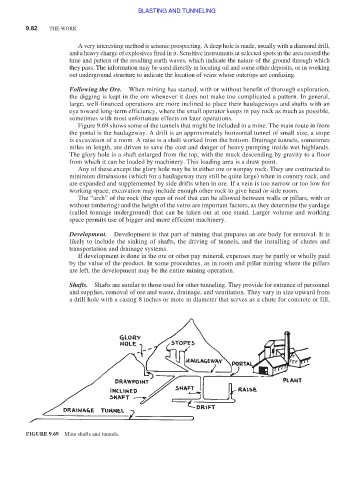Page 482 - Moving the Earth_ The Workbook of Excavation
P. 482
BLASTING AND TUNNELING
9.82 THE WORK
A very interesting method is seismic prospecting. A deep hole is made, usually with a diamond drill,
and a heavy charge of explosives fired in it. Sensitive instruments at selected spots in the area record the
time and pattern of the resulting earth waves, which indicate the nature of the ground through which
they pass. The information may be used directly in locating oil and some other deposits, or in working
out underground structure to indicate the location of veins whose outcrops are confusing.
Following the Ore. When mining has started, with or without benefit of thorough exploration,
the digging is kept in the ore whenever it does not make too complicated a pattern. In general,
large, well-financed operations are more inclined to place their haulageways and shafts with an
eye toward long-term efficiency, where the small operator keeps in pay rock as much as possible,
sometimes with most unfortunate effects on later operations.
Figure 9.69 shows some of the tunnels that might be included in a mine. The main route in from
the portal is the haulageway. A drift is an approximately horizontal tunnel of small size, a stope
is excavation of a room. A raise is a shaft worked from the bottom. Drainage tunnels, sometimes
miles in length, are driven to save the cost and danger of heavy pumping inside wet highlands.
The glory hole is a shaft enlarged from the top, with the muck descending by gravity to a floor
from which it can be loaded by machinery. This loading area is a draw point.
Any of these except the glory hole may be in either ore or nonpay rock. They are contracted to
minimum dimensions (which for a haulageway may still be quite large) when in country rock, and
are expanded and supplemented by side drifts when in ore. If a vein is too narrow or too low for
working space, excavation may include enough other rock to give head or side room.
The “arch” of the rock (the span of roof that can be allowed between walls or pillars, with or
without timbering) and the height of the veins are important factors, as they determine the yardage
(called tonnage underground) that can be taken out at one stand. Larger volume and working
space permits use of bigger and more efficient machinery.
Development. Development is that part of mining that prepares an ore body for removal. It is
likely to include the sinking of shafts, the driving of tunnels, and the installing of chutes and
transportation and drainage systems.
If development is done in the ore or other pay mineral, expenses may be partly or wholly paid
by the value of the product. In some procedures, as in room and pillar mining where the pillars
are left, the development may be the entire mining operation.
Shafts. Shafts are similar to those used for other tunneling. They provide for entrance of personnel
and supplies, removal of ore and waste, drainage, and ventilation. They vary in size upward from
a drill hole with a casing 8 inches or more in diameter that serves as a chute for concrete or fill,
FIGURE 9.69 Mine shafts and tunnels.

